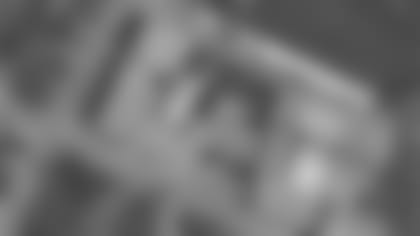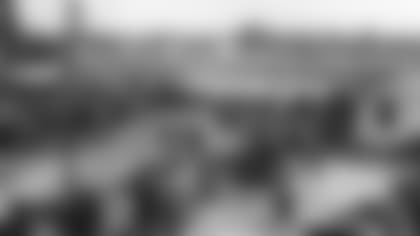Monte from Pierre, SD
I heard that in 1926 the Packers were almost kicked out of the league because several of their players were playing under assumed names. Is this true and why?
The Packers were actually kicked out in January 1922 for using at least three players with college eligibility remaining under assumed names in a non-league game against Racine. The game was played Dec. 4, 1921, in Milwaukee and was billed as a battle for the state championship. It's a long, involved story, but here's a somewhat condensed version. By the time the Packers were admitted to the American Professional Football Association (now the NFL) on Aug. 27, 1921, they had already started practicing with many of the same local players they used in 1919 and '20. Then they played four non-league games using several of those local players and some new recruits with state ties. But heading into their first APFA game on Oct. 23 against Minneapolis, the Packers added three players with pro experience within 48 hours of kickoff. Although the Packers were 4-0 in those non-league games, they may have had good reason for panic. The late Jack Rudolph, noted Green Bay historian, wrote years later the rumor was Green Bay had to beat Minneapolis to remain in the league. My suspicion is it wasn't necessarily a win-or-else ultimatum, but Green Bay needed to win, or at least be competitive, to have any chance of scheduling future home games or attractive opponents. Whatever, the Packers beat the Marines and added two more experienced pros the next week. Of those five new players, four played at Notre Dame with Curly Lambeau in 1918 or the following year. Turnover of the roster continued and in late November the Chicago Cardinals and Chicago Staleys (now Bears) both agreed to play the Packers. At the time, many games were scheduled week to week. It was a big deal for the Packers to land the games in Chicago, but by then they didn't have enough local players to even practice in Green Bay. Their players were scattered across the Midwest and met in Chicago to practice on Friday and Saturday before both games. According to The Milwaukee Journal, the Packers also practiced in Chicago before the Racine game. Meanwhile, rumors flew all week that Racine was loading up with ringers for the game. The result was a 3-3 tie. The next day, the Racine Journal-News reported, "Green Bay has (sic) several Notre Dame men from this year's lineup with her." The Journal-News listed them as Buck Shaw, Hunk Anderson and Fred Larson. What's more, among the lineups that appeared in the Racine, Green Bay and two Milwaukee papers, there were three positions at which three different starters were listed for the Packers. In all, a total of six different names were listed that hadn't previously played for them. News traveled slow in those days, and it wasn't until eight days later that the South Bend Tribune reported Anderson, Larson and Arthur Garvey, all of whom had eligibility remaining, had played for the Packers in Milwaukee, and that Notre Dame had declared them ineligible and stripped them of their football letters. Pro football came under fire and Green Bay was forced from the league at the next APFA meeting in January. Six months later, the APFA changed its name to the National Football League and thanks to Lambeau's persistence Green Bay was readmitted.
Tim from Aldie, VA
As a hobby genealogist, I recently found an article posted by someone who also is researching the Lambeau family. The article talks about a domestic shooting on the streets of Green Bay involving a Victor Lambeau. Do you know of this piece of history? Can you add anything about the incident?
Yes, I'm aware of it. Victor Lambeau was Curly's grandfather. Victor was the first in the family to emigrate from Belgium. He also was a mason and helped start a company that would build several well-known buildings in Green Bay. In 1891, seven years before Curly was born, Victor Lambeau encountered his wife at the corner of Main Street and Webster Avenue in Green Bay, drew a revolver from his hip pocket and shot her. He then shot and killed himself. Marie Lambeau, also born in Belgium, survived the shooting and lived another 31 years. Her son, Marcel Lambeau, Curly's father, also became a prominent contractor and helped build the Indian Packing Co., the Packers' first ballpark in Hagemeister Park and old City Stadium. Another son became a doctor. She also had three daughters.
John from San Diego, CA
As I understand it, the Armory is the large brick building to the northwest side of Green Bay East High School and the current East High football field (formerly City Stadium). Hagemeister Park, the original field location, was located where East High stands today. Is that true and is there a marker for Bellevue Park on the Packers Heritage Trail?
The Armory (see map, top center) was destroyed by fire in 1926. It was located closer to the end of Cherry Street and bordered the west end of City Stadium. The Armory opened at that location as the Hagemeister Park Pavilion in 1900. It was taken over by the Wisconsin National Guard in 1916 and renamed. As for the current garage, it was built in the early 1940s along with the large sandstone wall that became City Stadium's façade. As for the Hagemeister Park ballparks where the Packers played from 1920-22, yes, they were located virtually where East High stands today (red box below): from about the school's old main entrance on Walnut Street east to the end of today's building. And, yes, there's a marker for Bellevue Park on the Packers Heritage Trail.

Mike from Pine Beach, NJ
Can you please help me pin down a couple of facts about the locations of things at Hagemeister Park? Where exactly was the "Clubhouse" located? When the horse race track existed, how far north did it extend and how far south? I had always assumed the football field was laid out perpendicular to Baird Street. In an article in the October 2005 issue of "A Packer Scrapbook," there are photographs and discussion about the construction of the school and the location of one of the goal posts, but looking at the photographs in your 6/26/14 posting -- which I had seen before but didn't appreciate the details you pointed out -- it looks like the field may have been laid out parallel to Baird.
Mike, all good questions. The Hagemeister Park Clubhouse, a two-story social center, was located at the northeast corner of Baird and Walnut streets. The half-mile racetrack, used primarily for harness racing, was razed in 1908, 11 years before the Packers were founded. It extended from Cherry Street on the north to Stuart Street on the south. In other words, it covered much of today's Joannes Park. There's a Hagemeister Park map from 1918 that shows a large open area along Walnut Street marked Base Ball Field, which matches up with the red box above. There was no ballpark there in 1918 or '19. Green Bay's most recent minor league baseball park had been razed following the 1917 football season. That was why the Packers played on an open field in 1919. In 1920, a group headed by local typewriter salesman Neil Murphy built a fence around the playing field so the Packers could charge admission. Three days before the fourth game, Marcel Lambeau, with the help of Indian Packing Co. workers, built the first bleacher section with 700 seats. The next week, the buildup for the Packers-De Pere game was such that bleachers for another 800 were built. The Green Bay Press-Gazette reported those bleachers were erected "on the north side of the gridiron," suggesting the playing field ran east and west. That wooden ballpark was torn down following the season and another was put up in 1921 with more seating. The stories were more confusing that year, but the way I interpreted them was the bleacher seats were built along both the north and south sidelines and the playing field ran east and west. Again, based on the 1918 map, there really was no space for a ballpark north of Walnut other than where that open area was, which leads me to believe all the ballparks or playing fields used after 1911 were located in roughly the same spot. I'm aware of at least three pictures that show wooden goal posts in Hagemeister Park.
(Mary Jane Herber of the Brown County Library and Pat Ford, retired Brown Co. surveyor, helped with the research to determine the rough location of the Hagemeister buildings and field.)
Stephen from Chicago, IL
Great stuff you provide for Packers fans everywhere. My question is a simple one: With both the Bears and Packers tied for the Western Division lead at 10-1 during the 1941 season and both having lost only to each other, how was it determined to hold the play-in game at Wrigley instead of City Stadium?
I wish the answer was as simple. Representatives of the four NFL teams still in the running for the division titles met in Philadelphia on Dec. 1, 1941. Supposedly, the site was decided by a coin toss. But the Press-Gazette reported two days before the meeting the Packers weren't likely to bid for the game. In Chicago, the playoff drew more than 43,000 fans and sold out in hours. Green Bay had a rickety 25,000-seat stadium. I'm guessing potential gate receipts determined the site, and the coin toss was a formality.
For more of Cliff Christl's historical perspectives, click here.















